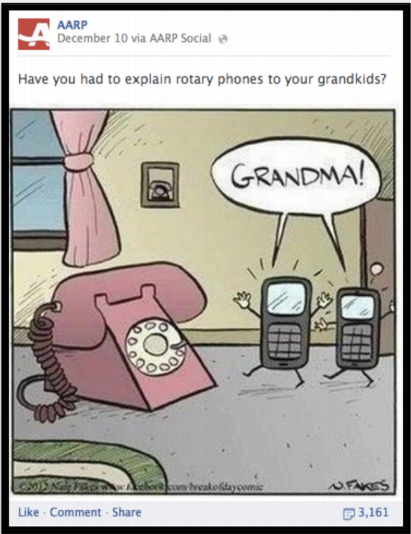
AARP may not be the first brand that comes to mind when you think of social businesses. After all, how social could the 50-plus set be, right?
However, Facebook is becoming increasingly more relevant to the older media consumer, with 47.7 million adults 50-plus visiting the website in October of this year alone, according to ComScore.
AARP realized the opportunity with Facebook early on, launching its presence on the platform in 2009. At first, the company didn’t really have a direction or a strategy in place for how it would reach consumers on the platform. AARP posted a lot of press releases and links to its website. The posts were sporadic, because at the time, the company was just experimenting.
Early in 2010, however, AARP began to understand it needed to have a succinct voice on Facebook, regardless of who within the organization was posting. It launched social media guidelines to help employees figure out how to frame their posts. At the beginning of 2011, the company put together a social media team, which consists of eight people (five community managers, a blog editor, a social media trainer and Tammy Gordon, the company’s first director of social communications and strategy). Gordon heads up the social media team at AARP.
“When we first started out on Facebook, we didn’t really know what we were there for,” Gordon said. “Like other companies so early on, we knew there was an opportunity, so we decided to test and learn so that we could be ahead of the game.”
AARP has learned that the posts that work best on Facebook are the ones that play into something happening in the news. Anything current, timely and really visual works. For the last year, AARP has been focused on figuring out a way to tell interesting stories through photos and videos, because these types of posts perform four to five times better than others. Also, this past year AARP got really serious about Facebook, dedicating a budget to increase its followers.
“It’s difficult to get a dramatic rise in fans without a promoted campaign,” Gordon said. “So this year we really made an effort to have a twofold strategy on Facebook. First was paid media for fan acquisition, and second was to really get to know our Facebook audience and better understand what type of content they prefer.”
Nostalgia and content that shines light on generational gaps have been doing well for the brand. For example, a cartoon the company posted on Facebook Dec. 10, pokes fun at 50-plus consumers that have had to explain what a rotary phone is to their grandkids. The post was shared about 3,000 times, and AARP considers that a win. Another post that did well was a video of Bruce Springsteen dancing with his mom on stage at a concert.
“That is our sweet spot,“ Gordon said. “We are a serious organization, and we fight for our members, but we can also be fun.”
Up until the beginning of 2012, when AARP had 80,000 fans on Facebook, its growth had been organic. When it began to run Facebook Ads, promoted posts specifically, it was able to accelerate its pace of growth. AARP reached 1 million members on Dec. 19.
“We’re really happy with our growth in 2012 and expect to grow even more and even faster in 2013,” Gordon said.
More in Marketing

Why the New York Times is forging connections with gamers as it diversifies its audience
The New York Times is not becoming a gaming company. But as it continues to diversify its editorial offerings for the digital era, the Times has embraced puzzle gamers as one of its core captive audiences, and it is taking ample advantage of its advantageous positioning in the space in 2024.

Why B2B marketers are advertising more like consumer brands to break through a crowded marketplace
Today’s marketing landscape is more fragmented than ever. Like consumer brands, business brands are looking to stand out in a crowded and competitive marketplace, making marketing tactics like streaming ads, influencers and humorous spots more appealing.

As draft puts WNBA in spotlight, the NBA is speeding up ballplayers’ transition to creators
The NBA’s star athletes are its greatest marketing asset.






